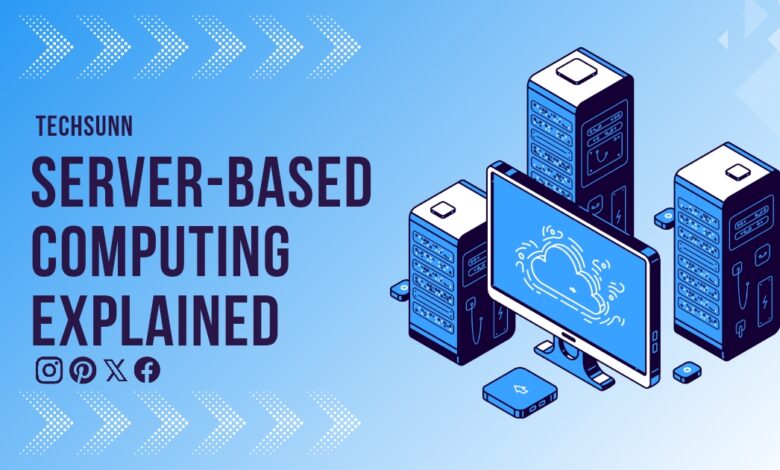Server-Based Computing Explained

Server-based computing unifies assets on a server, offering cost productivity, upgraded security, and worked on IT management for businesses.
Prologue to Server-Based Computing
In this present reality where technology is continually developing, understanding the framework that drives our day to day digital interactions is essential. One such foundation is server-based computing, a model that has been at the core of business operations for a really long time. Yet, what precisely is server-based computing, and for what reason is it so vital in the present tech landscape?
What is Server-Based Computing?
Server-based computing is an IT architecture where applications, information handling, and storage are facilitated on an incorporated server, and got to from a distance by client gadgets, frequently alluded to as “thin clients.” This arrangement appears differently in relation to traditional computing models where programming and information are put away on individual client gadgets.
A Concise History of Server-Based Computing
Server-based computing is certainly not another idea. It follows back to the beginning of centralized computer computing during the 1960s, where strong focal PCs dealt with all handling assignments. After some time, this developed into the client-server model we see today, where server-based computing assumes a significant part in conveying IT benefits proficiently.
Significance of Server-Based Computing in Present day IT
In the present quick moving world, businesses require dependable, adaptable, and secure IT arrangements. Server-based computing gives these benefits, making it a foundation of present day enterprise IT systems. Whether it’s for overseeing huge datasets, supporting remote work, or getting sensitive data, server-based computing is indispensable to progress.
How Server-Based Computing Functions
Understanding how server-based computing capabilities helps in getting a handle on its importance. It spins around concentrated management and a very much organized client-server architecture.
Unified Server Management
At the center of server-based computing is unified server management. Every critical application, documents, and resources are put away on a focal server, which is kept up with and refreshed by IT experts. This diminishes overt repetitiveness, guarantees predictable execution, and works on upkeep errands.
Client-Server Architecture
Server-based computing depends on the client-server architecture, where the server is the force to be reckoned with, taking care of all information handling and storage. Client gadgets, generally thin clients, are just endpoints that associate with the server to get to resources. This architecture is intended to be strong, guaranteeing that regardless of whether a client gadget falls flat, the server stays unaffected.
Thin Clients vs. Fat Clients
A vital differentiation in server-based computing is among thin and fat clients. Thin clients are lightweight gadgets with insignificant handling power, depending on the server for all undertakings. Fat clients, then again, have additional handling capabilities and can play out specific undertakings autonomously. Thin clients are more normal in server-based conditions because of their expense adequacy and simplicity of management.
Benefits of Server-Based Computing
The allure of server-based computing lies in its various benefits, which range from cost reserve funds to further developed security.
Cost Productivity
One of the essential advantages of server-based computing is cost productivity. By incorporating resources on a server, businesses can decrease the requirement for costly equipment on client gadgets. Additionally, upkeep and updates are simpler and less expensive, as they just should be applied to the server, not individual gadgets.
Upgraded Security
Security is a critical worry for any association. With server-based computing, all information is put away on the server, not on client gadgets, decreasing the gamble of information breaks. Moreover, unified security conventions can be executed, monitored, and refreshed all the more successfully, giving a more significant level of insurance against dangers.
Worked on Management
Overseeing IT foundation can be mind boggling, however server-based computing improves on this cycle. IT groups can convey, update, and manage programming from a solitary area, making it more straightforward to keep up with consistency across the association. This centralization additionally implies faster investigating and decreased margin time.
Scalability and Flexibility
Server-based computing offers unrivaled scalability. As an association develops, adding new clients or it is clear to grow storage capacity. The flexibility of this model likewise takes into account simple variation to changing business needs, whether it’s coordinating new applications or supporting additional clients.
Functional Utilizations of Server-Based Computing
Server-based computing is broadly utilized across different areas, each benefiting from its remarkable advantages.
Remote Work and Virtualization
In an era where remote work is turning into the standard, server-based computing gives the vital foundation to representatives to get to organization resources from anyplace. Virtualization, a vital part of this model, permits different clients to operate on a similar server while keeping up with their singular surroundings.
Instruction and Preparing Conditions
Instructive institutions and preparing focuses leverage server-based computing to give understudies and students admittance to learning materials, programming, and reenactments. This guarantees a reliable opportunity for growth, no matter what the gadget or area.
Enterprise Resource Planning (ERP)
Huge enterprises use server-based computing for ERP frameworks, which incorporate different business cycles like money, HR, and store network management. Incorporated servers guarantee that all divisions approach state-of-the-art data, smoothing out operations and navigation.
Medical care Frameworks
In the medical care industry, server-based computing is fundamental for overseeing patient records, planning, and analytic frameworks. The incorporated idea of this model guarantees that sensitive patient information is secure and available just to approved work force.
Expected Difficulties in Server-Based Computing
While the benefits are significant, server-based computing likewise accompanies its difficulties.
Network Reliance
A critical downside of server-based computing is its dependence on a steady organization association. Assuming the organization goes down, clients might lose admittance to critical applications and information, which can upset business operations.
Initial Arrangement Expenses
In spite of the fact that server-based computing can prompt long haul reserve funds, the initial arrangement expenses can be high. Businesses need to put resources into powerful server equipment, organizing hardware, and perhaps even server farms, contingent upon their scale.
Information Protection Concerns
Putting away all information on a focal server raises protection concerns, particularly for associations taking care of sensitive data. Guaranteeing consistence with information assurance guidelines and executing hearty security measures is vital to mitigate these dangers.
The Advancement and Eventual fate of Server-Based Computing
The fate of server-based computing is formed by arising technologies and advancing business needs.
The Job of Distributed computing
Distributed computing has upset server-based computing by presenting on-request resources and administrations. Numerous businesses are transitioning to mixture models that join on-premises servers with cloud answers for balance control and flexibility.
Progressions in Virtualization Technology
Virtualization keeps on progressing, empowering more productive utilization of server resources. As this technology develops, server-based computing will turn out to be much more remarkable, permitting associations to consistently run numerous operating frameworks and applications on a solitary server.
The Shift Towards Half and half Models
Half and half computing models, which mix server-based and distributed computing, are acquiring popularity. These models offer the smartest possible scenario — command over critical information and applications while leveraging the scalability of the cloud.
Conclusion
Server-based computing stays a vital piece of the IT landscape, offering a scope of benefits from cost reserve funds to improved security. While there are difficulties, for example, network reliance and initial arrangement costs, the advantages frequently offset the disadvantages. As technology keeps on developing, server-based computing will probably adjust, integrating more cloud-based and cross breed answers for satisfy the needs of present day businesses.



